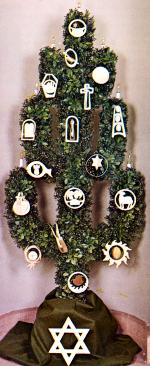Catholic Activity: Jesse Tree

DIRECTIONS
The representation of the Tree of Jesse is based upon the prophecy of Isaiah 11:1-2:
And there shall come forth a rod out of the stem of Jesse, and a branch shall grow out of his roots: and the spirit of the Lord shall rest upon him: the sprit of wisdom and understanding, the spirit of counsel and fortitude, the spirit of knowledge, and of the fear of the Lord.In works of art the genealogy of Christ (based on Matthew 1) is frequently shown in the form of a tree which springs from Jesse, the father of David, and bears as its fruit the various ancestors of Christ.
The Jesse Tree symbols transform a Christmas tree into a "family tree" of Christ, since each ornament is a symbol of an ancestor or of a prophecy which foretells his coming. Some of the symbols included are the sun, the tablets of the Law, the key of David, Bethlehem, the root of Jesse, Noah's ark, the Ark of the Covenant, the altar of holocaust, the apple, the Paschal Lamb, the pillar of fire, manna, the star of David, Jacob's ladder, Jonah in the whale, the Temple, the crown and the scepter, the sword of Judith, and the burning bush.
The sun represents Christ as bringing eternal life and light, and is based on the prophecy of Malachi: "But unto you that fear my name shall the Sun of righteousness arise with healing in his wings." The six-pointed Star of David symbolizes the lineage of Christ from the royal house of David. The burning bush symbolizes the Virgin Birth, and the prophecy of the birth is seen in the Bethlehem-emblem. The apple is a symbol of Christ, who took upon himself the burden of man's sin, and Jacob's ladder is interpreted as Christ reuniting mankind to God. The ladder has also been interpreted in a moral sense, with each of the fifteen rungs standing for a specific virtue. The lamb is one of the favorite, and most frequently used, symbols of Christ in all periods of Christian art. A typical reference is John 1:29, "The next day John seeth Jesus coming unto him, and saith, Behold the Lamb of God, which taketh away the sin of the world." Noah's ark is a symbol of baptism, and Jonah in the whale symbolizes death and resurrection.
The stories of the Old Testament have been an unlimited source of inspiration for the visual arts. The burning bush was the subject of the triptych painted by Nicolas Froment in the thirteenth century. The star of David was a popular symbol in stained glass windows, as at the Cathedral of Lyons.
The Jesse Tree was an early form of design for the stained glass windows of great cathedrals, such as Chartres. In the portrayal of the descent of Christ from the line of David, there may be as few as four or five figures or as many as fifty. The twisting branches of the tree always start with Jesse and end at the top with Christ. The Tree of Jesse window in the cathedral at Chartres is full of meaning and symbolism. In the lowest panel Jesse is lying upon a couch; from his loins rises the stem of a tree which branches out into scrolls enclosing seated figures of the sons of Jesse holding the branches. Next to the upper panel is the Virgin; the upper panel holds the figure of Christ, much larger, with the dove descending from above. On either side of the panels in semicircular spaces are the prophets who foretell the coming of Christ. A border of interlacing lines and flowers resembling those in the center panel completes the design of this famous window.
At Sens Cathedral the Jesse window is a little different, for it shows not only the ancestors of Christ; a donkey on one of the branches honors the animal that played so great a part in the life of Jesus.
The Advent Jesse Tree is fairly recent practice, trying to emphasize "Christ" in Christmas by studying His roots. A home Jesse Tree can be a small evergreen tree, artificial or real, bare branch set in a sturdy pot, or a wallhanging made of felt, posterboard or wood. Each evening in Advent a new symbol is placed on the tree, the Scripture verse is read and the significance in Salvation History is explained.
From The Trees of Christmas, by Edna Metcalfe, ©1979, Abingdon Press







